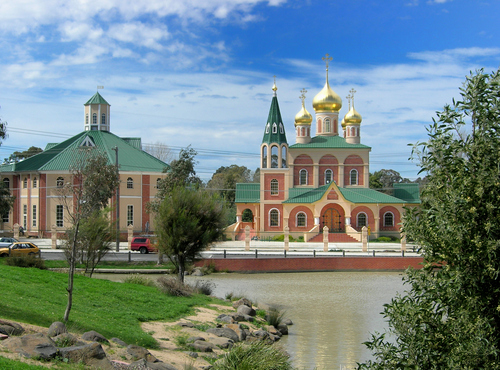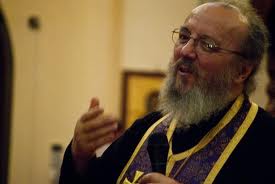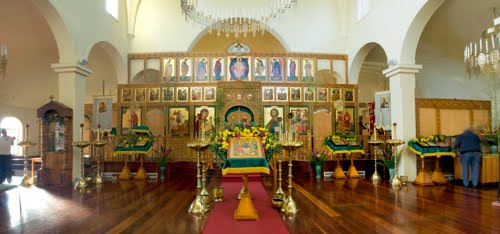Protopriest Nicholas Karipoff, Senior Priest of Protection Cathedral in Melbourne, Australia, spoke at a luncheon in Cabramatta’s parish hall held to benefit a convent in Bungarbee. Edineniye talked to Fr Nicholas on the history of the largest parish of the Russian Orthodox Church Outside of Russia in Melbourne.
* * *

The Protection Church in Melbourne, Australia.
—You grew up in Sydney, attended Protection Church in Cabramatta, and received your first religious instruction from Protopriest Rostislav Gan. In the 1980’s you moved to Melbourne and became the Senior Priest of Protection Cathedral. For thirty years now, the cathedral has been part of your life. How was it first established?
—Protection Parish in Melbourne has existed since 1949. Three years ago we celebrated our 60th anniversary. At the time, there were meetings of Orthodox Christians who helped lay the foundations of the community. At first they did not have their own church. The first post-war wave of immigrants rented various premises in which to hold divine services. In 1954, an old Anglican church was purchased, originally built in 1875 in the neo-Gothic style, and they still own this church. Now it is used by a small community headed by Fr Igor Filyanovsky. Even back in the 1950’s, the community members understood that this church was a temporary space, being limited in size, and the church and hall were nestled on a small parcel between two streets measuring only 711 square meters. For this reason, the church couldn’t accommodate the hundreds of worshipers who came on holidays, and neither could the parish hall, despite its reconstruction in the 1960’s. They had to make room for the parish school, and set out tables for parish meetings, and a stage for performances.
—When was
the decision made to build a new church?

Fr. Nicholas Karipoff.
—Under my predecessor, Fr Vladimir Evsiukov, discussions began to find a larger space. But they were unable to find a solution then. When I was appointed to this parish, I came from Sydney with my wife, and began to work here in 1981. I formed a small building committee which began to look for land to build on. We looked at a lot of parcels of land. In 1983, we found something and signed a contract. But the Lord deemed otherwise. The seller did not want to proceed, and we found ourselves looking again. At the end of that year, one of the active parishioners, the engineer Alexander Alexandrov, found a plot of land 5 kilometers outside of town where our present church was eventually built. At the time it wasn’t a nice area. There was closed dump across the street at an old brick factory. Many parishioners had a negative reaction to this. But the council decided to buy the parcel, at least as an investment. The price was very good.
Still, construction had to wait. Many older parishioners did not want to leave their familiar surroundings in Collingwood and were afraid of launching a new construction effort. “Who is going to pay for this, we are all retired,” they would say. Gradually, more middle-aged parishioners began to gather and in 1986, they began the design phase of the project. An architect prepared plans, submitted them to the municipality and soon received approval. But the foundation was only laid at the end of 1989. The late Bishop Paul blessed the new construction. To a great degree, we built the church by hand, one might say. Men would arrive on Saturdays, roll up their sleeves and work. There was a large group of strong men in the parish with construction experience. All the concrete, carpentry, welding and plastering work they did themselves. And not only the building but the decoration of the church—the candle stands, chandeliers and a great deal more. We invited woodcarvers from Russia, and they did a splendid job on the iconostasis and other icon frames.
—What style did you want for the church?
—We tried our best to use contemporary materials and technology but to build the church in the Yaroslav style of the 16th-17th centuries. The philosophical basis of this was provided by Fr Dimitry, who later became Bishop Daniel (Alexandrov). He was a sort of Leonardo da Vinci: he knew 15 languages, was a wonderful icon-painter, built several churches in America, and was just a remarkable person in general. He clearly, and strictly, advised us to build in the Yaroslav style, because that was the last genuinely-Russian church style.
—I know that the building process took a long time, not always smooth, but let us talk about the final stages.
—Yes, in fact construction took some time. We moved from the old church to the new one only in September, 2006. The new church was built a few years earlier, but we could not move in because the parish hall was not yet built. In Melbourne, a tradition evolved over decades that after Sunday Liturgy everyone would socialize at lunch. Our parishioners do not live near each other, so they take advantage of attending church to sit down afterwards, talk, and have a bite to eat. That is why we needed to finish the hall. The expenses were considerable, approaching a million dollars.
—A great deal of resources and energy were invested, and as a result, the church is magnificent, a beauty no matter how you look at it. The parish hall, which is actually a community center, has a kitchen and a school and other necessary space, large and comfortable.
—Actually, we are doing more work now. We decided that we need an elevator to the community center. It will be built on the outside. The parish school offers Russian language and the Law of God. The building has a large basement, where we plan to set up workshops, so that the old skills and habits can be passed to the new generation. I understood that when people participate in creating a church with their own hands, they have a completely different attitude towards it. They feel that this is their home. When we clean the church, some 40-50 people gather. Our record was 75 adults, plus many children.
 |
| The interior of the Protection Church, Melbourne. |
—Tell us about your parishioners. How many attend services, how many young people do you have? Which immigration waves did most of them come from?
— I estimate that we minister to 4,000 people. These include people who turn to us for various needs. Naturally, they do not all attend services every Sunday, and only about half come on Pascha and join the procession of the cross. Sunday services gather about two hundred parishioners. Our main core includes about 400 people.
The demographics of our church have changed dramatically. A whole generation of those who came as adults after the war has now departed. The average age of our parishioners is about 40. Many young families come to church with little kids, we baptize a lot of children now. I think that we had a record number of baptisms, maybe only in the early 1960’s were there more. This is a great joy. We have a mixed parish, and in recent years more and more new Russian immigrants are coming. Our parish is open to non-Russians, too. We have people of other Orthodox cultures, too—Greeks, Macedonians, Serbs and Bulgarians. There are unique mixed marriages. Two weeks ago we had a wedding—the groom was an Orthodox Persian, the bride Rumanian. We have had a Lebanese man marry a Vietnamese woman.
—What language do you serve in?
—Generally in Church Slavonic, though we often use English out of necessity. I have read sermons in two languages now for many years. We also insert English into certain portions of divine services so that those you don’t understand Russia would not feel excluded.
—What tendencies are you noticing in the parish, what difficulties do the parish council face?
—Our parish council is full of energy and hope for the future. At the end of last year, I submitted a plan for expansion to the council. An important phase of our existence is coming to an end, the construction of our church and parish hall. But we can’t rest on our laurels. We must think about the future. We are considering introducing new officers in the parish council, administrative and community figures, in youth ministry, and maybe these would receive some kind of compensation.
—Has the parish paid off the construction loans?
— Yes, we have no debt. We had to sell some property to settle our obligations. Life has become easier now. The budget for the next few years includes several hundred thousand dollars.
—You are the Senior Priest of the cathedral, but you have other priests here, too.
—We have a lot of clergymen here. I have two auxiliary helpers, Fr Nicholas Dalinkevich and Fr Peter Scheko. Protodeacon Alexander Abramov, too, who also works in the Russian Ethnic Representative Council.
Temporarily, for two years now, we have Hieromonk Kirill Garvas and Deacon E. Mishriki, an Egyptian clergyman. They serve with us on Sunday. That is why English is used more often.
—Who is in the parish council?
—For many years, when the church was being built, the warden was Innokenty Kozulin. Unfortunately, he did not live to see the finished church. Mikhail Ivanovich Styrkul is now the Warden. The parish Treasurer is Alexander Belotserkovsky, a highly-valued, active individual who joins me in the parish council. Nicholas Vyrubov is the Secretary. We have a good parish council. The energetic Liubov Kovalenko has been the Senior Sister for about eight years. Her son Nicholas is our choir director. We also have another choir director, Dimitry Suprunovich, they work together.
—Your feast day is the Protection of the Most-Holy Mother of God, October 14. Is this a good opportunity for visitors from other parishes to attend your festive service and hear the choir sing?
—We are thinking about it now. This year the feast day falls on a Sunday, so we expect a lot of people. Our hall can accommodate about 200 people. In order to make room for everyone, we will need to set up tents on the street for another hundred or so. So parish life is thriving.
I would like to show our children, our growing youth, how we live, to tell our neighbors about Orthodox Christianity, about our rich spiritual culture. The Church is not something remote, but part of daily life.
Our church draws a good deal of attention from the local Australian population. Groups of children from Catholic and Anglican schools often visit, as do scouts and retirees who want to learn more about our culture, to see what our divine services are like. They listen, the watch, often posing serious questions, so it is obvious that our faith evokes great interest, even on a cultural level.
The role of the Church in preserving Russian culture abroad cannot be overstated. If not for the regular gatherings of the Russian community in Orthodox churches, the Russian culture, its traditions would disperse into general Australian culture by the second generation. Protection Cathedral in Melbourne has been playing a huge role in the Russian community for 63 years.
